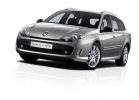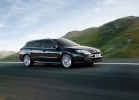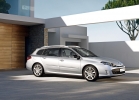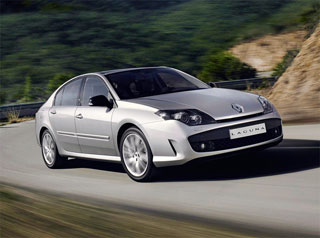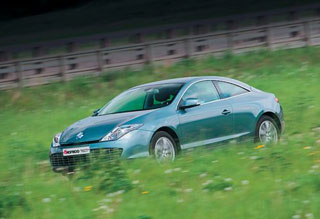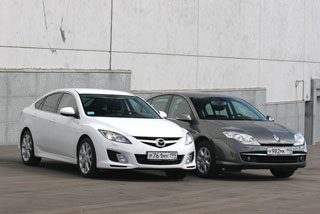Renault Laguna test drive since 2007 hatchback
France - Japan - an account equal
Universals, more precisely, cars with a body of type of station wagon have always caused a very ambiguous reaction from customers. Some models, after the version of the version with this, initially a utilitarian type of body suddenly became almost cult, while others simply turned out to be so alien to the consumer’s mind that now they can be found only in the corporate directory - there was so small the volume of sales. And what is most interesting, there was no correct universal then to this day. No one really knows what the buyer is guided by, preferring a particular model with the station wagon. It seems, according to the logic of things, the emphasis when creating such models should be placed on the volume of the luggage compartment and carrying capacity, but there are many commercially successful universals, the possibilities for transporting goods of which do not withstand any criticism. For example, the BMW 3 Touring - a stylish rear -wheel drive machine can please you with excellent dynamics and handling, as well as the highest quality of assembly and reliability, but the volume of the trunk of this station wagon does not at all have a large -sized cargo. And even more so - the manufacturer deliberately supports buyers' desire to call these models of sports universals and often offers models with a light velor upholstery of the cargo compartment! If you think that these are isolated cases, then you are mistaken. More recently, the ALFA Romeo 156 SW visited our test, which has a cargo compartment, very small, I must say, was generally sheathed with light beige skin. And monsters such as Audi RS6 Avantes or Mercedes-Benz E55 AMG T-Modell do not fit into any framework. Imagine a family station wagon, accelerating from a place to hundreds in 4.5 seconds! Naturally, after such an attraction, it would never occur to anyone to ask the volume of the trunk or the capabilities of transportation in this car of large -sized or long goods ...But most of the station wagons, which in a huge number of wheel on roads around the world, naturally have nothing to do with the above unique - these are ordinary cars with increased capabilities in terms of cargo transportation and transformation of the salon, designed for operation under ordinary conditions. The buyer only needs to choose the size, today modifications with this type of body are offered in almost all classes, with the exception of subcompacts and representative models. Although nothing forever under the Moon - recently on several Internet sites there was information about preparing for the production of the representative Audi A8 with a universal body. Can you imagine a barn for more than a hundred thousand dollars?
Today's heroes are not at all hot and not the most expensive representatives of the vast family of passenger universals. These are two ordinary models of the middle class, in the basic configuration, with front -wheel drive and basic 1.8 -liter engines - that is, the minimum possible for these models.
Renault Laguna II appeared on our market for a relatively long time, and the version with the body of the station wagon was present in the range from the very beginning of production, although the station wagons usually appear much later. Presumably, the rapid appearance of the station wagon to some extent provoked a small range of the bodies with which this model is produced. As in the previous generation, Renault Laguna has no version with the sedan body. And this means that if the station wagon did not appear immediately after the start of production, the company could lose potential buyers: it would be possible to choose only a few versions of the hatchback. Mazda 6 has, followers of the 626th model popular with us and around the world, with the choice of a body, on the contrary, full order - there is a sedan, a five -door hatchback and the universal itself. The model began to be sold in our market in the spring, but the last type of body became available only a couple of months ago.
Both cars look, I must say, just wonderful: the universal body, in my opinion, is initially more harmonious than a sedan. The station wagon that Japanese, that French, is simply pleasing to the eye - in their appearance there is no raid of utilitarianism inherent in models with a large trunk. True, the six in this regard is more traditional, in her design there is nothing that for which the gaze could catch on, it is just a solid and beautiful car. The Laguna II station wagon is simply out of competition: the car is so beautiful that I don’t want to think about any other type of body, except about a five -door carriage. Inside, everything is exactly the opposite - I like the more Mazda with its modest, but very high -quality and comfortable interior, verified by ergonomics and magnificent decoration materials than Renault with its avant -garde forms and small nuances. Even in Laguna II, I do not like the key, which is a plastic card. In order to start the car, this card must be inserted into the slot at the bottom of the central console, and then press the Stop/Start button, located at the site of the usual ignition lock. This thing seems to be interesting, especially since the system can be configured in such a way that it will recognize the owner a few meters before the car, and open the door for him. But in the course of real operation (autopanorama journalists ride such a car) turned out that this device is not very convenient. In order to drown out and close the car, you will have to perform three or four operations instead of the usual two. It would be better if the engine starting circuit was similar to that used on the new BMW seven, there the keyponder key itself is a button, and the engine is launched by pressing it.
How to test station wagons? Management, accelerated dynamics, resistance at high speeds, tendency to ski or demolition - all this, it seems to me, is not so relevant in this case. In the end, if a person decided to buy a relatively expensive car with such a rather rare type of body, then he did it, apparently not just like that, in this version he was attracted by something that is not in other cars. And what can the station wagon boast? That's right - a cargo compartment. Although there is nothing to brag about it, because In the normal position, both station wagons do not affect the luggage compartment with the volume of the luggage compartment, and the numbers characterizing the capacity of the trunk are not record. If the rear seats are not folded, then the luggage compartment of the Renault Laguna II Grandtour and Mazda 6 Station Wagon is 475 and 505 liters, respectively. For transportation of large and long goods, the rear seats can be folded, and in both cars they fold both together and separately - in a proportion of 1/3 and 2/3. And if the rear seats are folded, removing the folding curtain, the volume of the luggage compartment will increase many times - at least 1,500 liters of free space will be at your disposal.
Two station wagons drive almost the same: 1.8-liter motors in both cases cope well with their work, without forcing to constantly regret a lack of power. Moreover, I do not see much sense in surcharge for a 2.0-liter motor, which will be more powerful by 10-20 horses, because The basic motor is enough for the eyes. Although there are some differences between cars: with the same working volume, their motors show a completely different character. For example, the Renault Laguna II motor is slightly phlegmatic on the bottoms, which, coupled with a completely non -informative, but very light clutch pedal, makes the car demanding on the driver: during the trip at least once, but it will certainly die out when touched! But then - absolutely no problems: even work, a pleasant capture of 3500 rpm and a rather low noise level. However, if you twist the motor to ringing, then its sound penetrates the salon quite strongly. In Mazda, the motor works a little louder and louder, but this seems to be a national feature of all models of this brand. The MPV and models of the third family, and even the luxurious Xedos 9 suffer exactly the same disadvantage. But this does not mean that Mazda 6 is a noisy car, noise insulation here is on top, and nothing but a rustling motor is heard in motion.
The sports spirit of the entire sixth family is also present in the station wagon, despite the fact that another adjustable rear suspension is installed here. Partly the motor is also to blame for this. It is extremely steep and pleases simply an endless supply of torque. Although, like Lagunovsky, this 16-valve engine also does not like low revolutions and at 50 km/h the fourth gear is if not violence over the engine, then at least mockery of it. But if you do not give the tachometer to the arrow lower below 2000 rpm, Mazda will be willing to go in any gear - even on the fifth and under the hill. When you drive like this, transplanting from one car to another, it immediately becomes noticeable how much the approach to the construction of cars varies: Mazda is noticeably shorter than that of Renault, and this allows the Japanese machine to seem much more dynamic. Although in fact, everything is different: the 116-horsepower engine of the French station wagon provides him a hundred from a place in just 10.8 seconds, while a Japanese car, having 120 horses at his disposal, does this exercise in exactly 11 seconds. The difference, of course, is insignificant and even more - invisible during the usual operation, but I repeat once again - according to the sled impressions of Mazda 6 1.8, it seems more driver.
What is the conclusion? If you do not find fault with the little things, then both cars are good in the middle class - well -designed models with a clear separation of the image. The French car is for people who are ready to forgive some nuances in gratitude for the attractive and harmonious appearance. The Japanese machine, on the contrary, is for people of pragmatic - business, grip, sober -minded. This does not mean at all that the car presses on the owner with its charisma, no. In the end, this is not a BMW M3 or Jaguar XK8, where the compliance of the image and style is put in first place and which simply oblige the owner to ride, dress, etc. Both cars may well be a family car, although in our area few can afford such transport for traveling to a picnic, and a workhorse for a businessman, because a huge luggage compartment allows you to transport goods.
We come to the conclusion that both Mazda 6 and the second Laguna have very little fundamental differences from each other, and the difference is only in a different constructive approach when developing certain nodes and assemblies. The front-wheel drive, transversely located four-cylinder engines (for Laguna II, a 3.0-liter V6 is also possible), automatic or mechanical gearboxes, several equipment levels, although it should be noted that both cars are very well equipped in the database. There is almost everything in the list of standard equipment, so you will have to pay extra when ordering a car only for some special excesses, without which you do not see the point in buying a new expensive car.
Soon, our market will arrive at all -wheel drive versions of Mazda 6, which will be sold only in the top configuration - with a 2.3 -liter engine, an automatic checkpoint, etc. Renault, unfortunately, does not have all -wheel drive, and in the near future the appearance of such a modification is not expected.
Text: Pavel Kozlovsky and Sergey Mitskevich
Video Test Drive Renault Laguna since 2007
Renault Laguna crash tests since 2007
Test drive by Renault Laguna since 2007
Renault Laguna Crash Test since 2007
Krassh Test: Detailed Information36%
Driver and passengers
10%
Pedestrians
41%
Children-passengers



